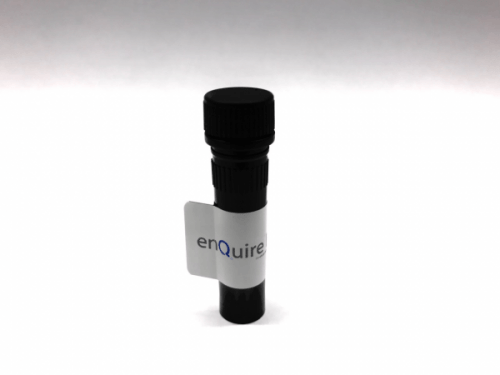Human, Mouse (-), and Rat (-) Anti-GLG1 Antibody Product Attributes
GLG1 Previously Observed Antibody Staining Patterns
Observed Subcellular, Organelle Specific Staining Data:
Anti-GLG1 antibody staining is expected to be primarily localized to the golgi apparatus.
Observed Antibody Staining Data By Tissue Type:
Variations in GLG1 antibody staining intensity in immunohistochemistry on tissue sections are present across different anatomical locations. An intense signal was observed in cells in the glomeruli in kidney, cells in the molecular layer in cerebellum, cells in the red pulp in spleen, cells in the tubules in kidney, decidual cells in the placenta, fibroblasts in skin and mesenchymal tissue, germinal center cells in the tonsil, glandular cells in the adrenal gland, appendix, colon, duodenum, endometrium, epididymis, gallbladder, prostate, salivary gland and stomach, islets of Langerhans in pancreas, Leydig cells in the testis, lymphoid tissue in appendix, macrophages in lung, neuronal cells in the caudate nucleus, cerebral cortex and hippocampus, neuropil in cerebral cortex, non-germinal center cells in the tonsil, peripheral nerve in mesenchymal tissue, Purkinje cells in the cerebellum, respiratory epithelial cells in the bronchus and nasopharynx and trophoblastic cells in the placenta. More moderate antibody staining intensity was present in cells in the glomeruli in kidney, cells in the molecular layer in cerebellum, cells in the red pulp in spleen, cells in the tubules in kidney, decidual cells in the placenta, fibroblasts in skin and mesenchymal tissue, germinal center cells in the tonsil, glandular cells in the adrenal gland, appendix, colon, duodenum, endometrium, epididymis, gallbladder, prostate, salivary gland and stomach, islets of Langerhans in pancreas, Leydig cells in the testis, lymphoid tissue in appendix, macrophages in lung, neuronal cells in the caudate nucleus, cerebral cortex and hippocampus, neuropil in cerebral cortex, non-germinal center cells in the tonsil, peripheral nerve in mesenchymal tissue, Purkinje cells in the cerebellum, respiratory epithelial cells in the bronchus and nasopharynx and trophoblastic cells in the placenta. Low, but measureable presence of GLG1 could be seen in cells in the seminiferous ducts in testis, epidermal cells in the skin, glial cells in the caudate nucleus, cerebral cortex and hippocampus and pneumocytes in lung. We were unable to detect GLG1 in other tissues. Disease states, inflammation, and other physiological changes can have a substantial impact on antibody staining patterns. These measurements were all taken in tissues deemed normal or from patients without known disease.
Observed Antibody Staining Data By Tissue Disease Status:
Tissues from cancer patients, for instance, have their own distinct pattern of GLG1 expression as measured by anti-GLG1 antibody immunohistochemical staining. The average level of expression by tumor is summarized in the table below. The variability row represents patient to patient variability in IHC staining.
| Sample Type | breast cancer | carcinoid | cervical cancer | colorectal cancer | endometrial cancer | glioma | head and neck cancer | liver cancer | lung cancer | lymphoma | melanoma | ovarian cancer | pancreatic cancer | prostate cancer | renal cancer | skin cancer | stomach cancer | testicular cancer | thyroid cancer | urothelial cancer |
|---|---|---|---|---|---|---|---|---|---|---|---|---|---|---|---|---|---|---|---|---|
| Signal Intensity | ++ | ++ | ++ | +++ | +++ | ++ | ++ | +++ | ++ | + | ++ | ++ | ++ | ++ | + | + | ++ | +++ | +++ | +++ |
| GLG1 Variability | ++ | ++ | ++ | ++ | + | ++ | ++ | ++ | ++ | ++ | ++ | ++ | ++ | ++ | ++ | ++ | ++ | ++ | + | ++ |
| GLG1 General Information | |
|---|---|
| Alternate Names | |
| Golgi apparatus protein 1, GLG1 | |
| Molecular Weight | |
| 134kDa | |
| Chromosomal Location | |
| 16q22.3 | |
| Curated Database and Bioinformatic Data | |
| Gene Symbol | GLG1 |
| Entrez Gene ID | 2734 |
| Ensemble Gene ID | ENSG00000090863 |
| RefSeq Protein Accession(s) | NP_001139138, NP_036333, NP_001139139 |
| RefSeq mRNA Accession(s) | NM_001145666, NR_027264, NM_001145667, NM_012201, NR_027265 |
| RefSeq Genomic Accession(s) | NC_000016, NC_018927 |
| UniProt ID(s) | Q92896 |
| UniGene ID(s) | Q92896 |
| HGNC ID(s) | 4316 |
| Cosmic ID(s) | GLG1 |
| KEGG Gene ID(s) | hsa:2734 |
| PharmGKB ID(s) | PA28719 |
| General Description of GLG1. | |
| This MAb recognizes a protein of 134kDa, which binds fibroblast growth factor, E-selectin (cell-adhesion lectin on endothelial cells mediating the binding of neutrophils). Fucosylation is essential for binding to E-selectin. It contains sialic acid residues, 16 Cys-rich GLG1 repeats. This MAb can be used to stain the Golgi complex in cell or tissue preparations, can be used as a Golgi marker in subcellular fractions. It produces a diffuse staining pattern of the Golgi zone in normal, malignant cells. This MAb is an excellent marker for human cells in xenographic model research. It reacts specifically with human cells. The Golgi apparatus is an organelle present in all eukaryotic cells that forms a part of the endomembrane system. The primary function of the Golgi apparatus is to process, package macromolecules synthesized by the cell for exocytosis or use within the cell. The Golgi is made up of a stack of flattened, membrane-bound sacs known as cisternae, with three functional regions: the cis face, medial region, trans face. Each region consists of various enzymes that selectively modify the macromolecules passing though them, depending on where they are destined to reside. Several spherical vesicles that have budded off of the Golgi are present surrounding the main cisternae. The Golgi tends to be more pronounced, numerous in cells that make, secrete many substances such as plasma B cells. | |




Reviews
There are no reviews yet.